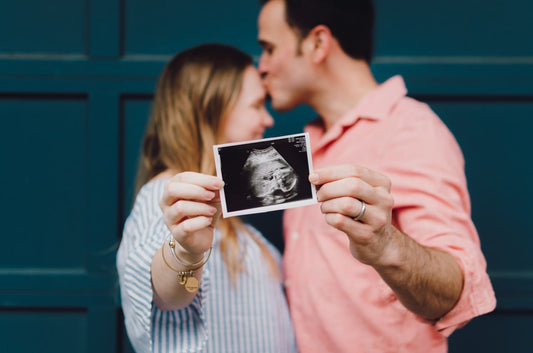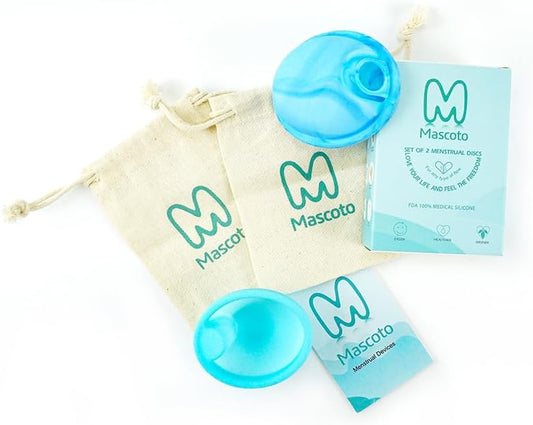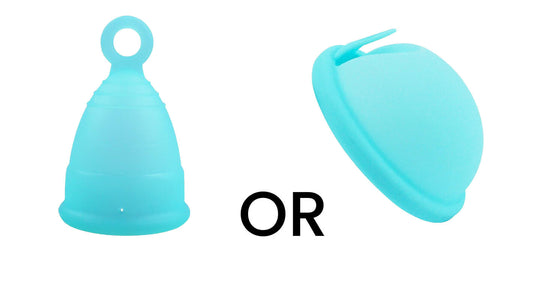How to Use Menstrual Cups: Insertion and Removing Tips
Share
Table of Content:
- Introduction
- Prior to First-Time Use
- How to Sterilise a Cup
- Inserting the Menstrual Cup
- Menstrual Cup Removal
- Cleaning and Maintaining the Menstrual Cup
- Conclusion: Encouragement and empowerment for menstrual cup users
- Using Menstrual Cup FAQs
1. Introduction
Using a menstrual cup looks like a simple task, but even the simplest actions sometimes require clear explanations. For example, many women find themselves in difficulty with insertion cups.
In this article, we will provide easy-to-understand instructions on inserting, removing, and storing menstrual cups. Our aim is to ensure that every person can confidently do that with comfort and no stress.
2. Prior to First-Time Use: cleaning and sterilising the cup
Before using a menstrual cup for the first time, it's crucial to clean and sterilise it properly to ensure hygiene and reduce the risk of any potential infections. Here's a step-by-step guide on how to prepare a menstrual cup for first-time use:
- Wash Your Hands: Start by thoroughly washing your hands with soap and water to ensure cleanliness during the entire process.
- Sterilise the Cup: To sterilise the menstrual cup, you have a few options. For more information on sterilising a cup, see the next section.
- Rinse Thoroughly: After sterilisation, remove the cup from the boiling water or sterilising solution and rinse it thoroughly with clean water. Make sure to rinse off any residue or cleaning product completely.
- Inspect for Damage: While rinsing, take a moment to inspect the cup for any signs of damage such as tears, cracks, or deformities. If you notice any damage, it's best to replace the cup to ensure proper functionality.
- Store in a Clean, Dry Container: Once the cup is clean and dry, store it in a clean and dry container specifically designated for your menstrual cup. Avoid using airtight containers, as they can trap moisture and promote bacterial growth. Some menstrual cup brands provide storage pouches or cases for convenient and hygienic storage.
3. How to Sterilise a Cup
To ensure there are no bacteria, so it'll be safe and hygienic to use, you have to sterilise your cup. This can be done in a number of ways.
- Boiling Method: Place the cup in a pot of boiling water and let it boil for 5-10 minutes. Ensure that the cup is fully submerged and not touching the sides or bottom of the pot to prevent damage. Use caution when handling the hot cup afterward.
- Sterilising Solution: Another option is to use a sterilising solution specifically designed for menstrual cups. Follow the instructions provided with the solution, as different brands may have different guidelines.
- Microwave Steriliser: If you have a microwave steriliser specifically designed for menstrual cups, you can use that as per the manufacturer's instructions.
4. Inserting the Menstrual Cup
Different folding technique
Inserting a menstrual cup may seem intimidating at first, but with the right folding technique, it can be easier and more comfortable. There are at least 8 different techniques for folding the menstrual cup: C or U, Punch Down, 7 (seven), Origami, S, M, E or Squiggle, Triangle, and Diamond folds.
But here we will look at three of the commonly used and easiest ways to do this: C or U, Punch Down, 7 (seven) folds.

C-fold:
- Press the rim of the cup together to form a "C" shape.
- Hold the folded cup firmly between your thumb and forefinger.
- Relax your vaginal muscles and gently separate the labia with your free hand.
- Insert the folded cup into your vagina, rim first, at a 45-degree angle.
- Push the cup in until the stem is just inside the vaginal opening.
- Once the cup is inside, it will unfold and create a seal against the vaginal walls. To ensure a proper seal, you can rotate the cup slightly or gently tug on the stem.
Punch-down fold:
- Press the rim of the cup down into the centre of the cup with your thumb.
- The following steps should be repeated from the instructions above.
7-fold:
- Flatten the cup by pressing one side of the rim down toward the base of the cup.
- Fold the cup in half vertically, creating a "7" shape.
- The following steps should be repeated from the instructions above.
Remember, it may take some practice to find the folding technique that works best for you. It's important to relax, take your time, and be gentle during insertion. If one folding technique doesn't feel comfortable or doesn't create a proper seal, feel free to try another technique until you find the one that suits you. With patience and practice, inserting a menstrual cup will become easier and more familiar.
Useful tips for comfortable insertion
- Relax: Before inserting the cup, take a moment to relax your body and mind. Tension can make the process more challenging. Find a comfortable position, take deep breaths, and try to remain calm.
- Lubrication: Applying water-based lubricant around the rim of the cup can help with insertion, especially if you're experiencing dryness. It can make the process smoother and more comfortable.
- Find the Right Angle: Insert the cup at a 45-degree angle towards your tailbone, rather than straight up. This can make it easier to navigate the vaginal canal and find a comfortable position for the cup.
- Trim the Stem (if needed): Some menstrual cups come with a stem at the base for easy removal. If you find the stem uncomfortable or poking, you can trim it to a length that feels more comfortable for you. Just be careful not to trim it too short, as you still need to be able to reach and grip the cup for removal.
- Take Your Time: Inserting a menstrual cup may require some practice. Don't rush the process. Take your time to fold the cup properly, find the right angle, and gently guide it into your vagina. Slow and steady movements can help make the process more comfortable.
- Try Different Folds: Experiment with different folding techniques, such as the C-fold, punch-down fold, or 7-fold, to find the one that works best for you. Different folds can affect the cup's size and shape during insertion, so find the one that feels most comfortable and allows for easy insertion.
- Be Patient: It may take a few cycles to get accustomed to using a menstrual cup comfortably. Don't get discouraged if it doesn't feel perfect right away. With practice and familiarity, insertion will become easier and more comfortable over time.
Ensuring a Proper Fit
To ensure that your menstrual cup is properly positioned inside your vagina, gently insert your index or middle finger into your vagina until you reach the base of the cup. Feel around the cup to ensure that it has fully opened and created a seal against the vaginal walls. The cup should feel round and not folded or collapsed. Check if the cup is positioned horizontally, rather than tilted or slanted. It should be centred and sit below the cervix. Give the cup a gentle tug to ensure it is properly suctioned to the vaginal walls. If you feel resistance or the cup doesn't move easily, it is likely in the correct position. Run your finger along the base of the cup to check if it feels comfortable and properly positioned. There should be no discomfort, poking, or protrusion of the stem. If you feel any leaks, pressure, or discomfort, it may indicate that the cup is not properly positioned. In such cases, you can try readjusting the cup by gently rotating it or pushing it higher or lower until it feels comfortable and secure.
Remember that it may take a few cycles to become familiar with checking the position of your menstrual cup. With practice, you will develop a better sense of how it should feel when properly positioned. If you have concerns about the position or fit of your cup, it can be helpful to consult with a healthcare professional or seek guidance from experienced cup users who can provide personalized advice.
5. Menstrual Cup Removal
Here is a step-by-step guide on how to remove a menstrual cup:
- As always, hygiene is paramount: wash your hands thoroughly before removing the cup to ensure cleanliness.
- Find a comfortable position, such as squatting, sitting on the toilet, or standing with one leg elevated. Relax your muscles to make the removal process easier.
- Insert your thumb and index or middle finger into your vagina to reach the base of the cup.
- Locate the base of the cup, which is usually the stem or a small grip at the bottom. Gently grip the base of the cup, making sure not to squeeze it too tightly to avoid spilling the contents.
- Slowly and gently pull the cup downward, using a wiggling or rocking motion if necessary. Take your time to release the suction and ease the cup out. Don't pull too quickly or forcefully, as this can cause discomfort or spillage.
- Once the cup is near the vaginal opening, tilt it slightly to the side to break the seal completely. This will allow air to enter and make the removal easier.
- Empty the contents of the cup into the toilet or sink. Rinse the cup with water if desired, or wipe it clean with toilet paper.
- Wash the cup thoroughly with mild, unscented soap and warm water. Ensure that all residues are removed. Alternatively, you can also use a designated menstrual cup cleanser.
- After washing, sterilise the cup by boiling it in water for a few minutes or following the manufacturer's sterilisation instructions. Sterilisation is particularly important before and after your menstrual cycle.
- Once the cup is clean and dry, store it in a clean and breathable container until its next use. Avoid using airtight containers, as they can trap moisture and promote bacterial growth.
6. Cleaning and Maintaining the Menstrual Cup
Proper cleaning methods
Cleaning your menstrual cup properly is essential to maintain its hygiene and longevity. Here are the steps to follow for proper cleaning:
- Empty the cup: Remove the cup from your vagina and empty the contents into the toilet.
- Rinse with cold water: Rinse the cup with cold water to remove any remaining menstrual fluid. Avoid using hot water as it can cause the blood to coagulate and make cleaning more difficult.
- Wash with mild soap: After rinsing, wash the cup with a mild, unscented, and pH-balanced soap. Make sure to lather the cup well, including the inside and outside surfaces. Gently scrub the air holes and the rim to remove any residue.
- Rinse thoroughly: Rinse the cup with clean, cold water to remove all traces of soap. Make sure there are no soap residues left, as they can cause irritation or infections.
- Sterilise the cup: At the end of your menstrual cycle, it's recommended to sterilise your cup before storing it. You can do this by boiling the cup in a pot of water for 5-10 minutes. Ensure that the cup is fully submerged and not touching the sides or bottom of the pot to prevent damage.
- Dry and store: Once the cup is sterilised, allow it to air dry completely before storing it. Avoid using tissue or cloth to dry it, as they can leave fibres behind. Store the cup in a breathable fabric bag or container in a clean and dry place.
Additional tips
Avoid using harsh cleansers, vinegar, or bleach, as they can damage the cup or cause irritation.
If you don't have access to clean water or soap, you can use a menstrual cup wipe or a specially formulated cup cleanser.
Be mindful of any discoloration or odour that persists even after cleaning. If this happens, consider replacing your cup, as it may be compromised or damaged.
Remember to refer to the specific cleaning instructions provided by the manufacturer of your menstrual cup, as different brands may have slight variations in their recommended cleaning methods.
Storing the cup between cycles
Proper storage of your menstrual cup between cycles is important to maintain its cleanliness and condition. Here are some guidelines on how to store a menstrual cup:
- Clean and dry: Before storing the cup, make sure it is thoroughly cleaned and completely dry. Follow the cleaning instructions mentioned earlier to ensure it is free from any residues.
- Choose a breathable container: It's best to store the cup in a breathable fabric bag or a designated container specifically designed for menstrual cups. Avoid using airtight or plastic containers, as they can trap moisture and promote the growth of bacteria.
- Keep it in a clean and dry place: Find a clean and dry area for storage, away from direct sunlight and moisture. Ideally, choose a spot that is not exposed to dust or other potential contaminants.
- Avoid strong odours: Keep the cup away from strong-smelling substances such as perfumes, essential oils, or cleaning products, as it can absorb odours.
- Do not store near pets or children: Ensure that the cup is stored out of reach of pets or children to prevent any accidental damage or contamination.
- Check for any damage: Before using the cup in the next cycle, inspect it for any signs of damage, such as cracks, tears, or deformities. If you notice any issues, it is recommended to replace the cup.
By following these storage guidelines, you can help maintain the cleanliness and longevity of your menstrual cup, ensuring it is ready for use when your next menstrual cycle begins.
7. Conclusion: Encouragement and empowerment for menstrual cup users
Using a menstrual cup empowers you to take control of your menstrual health and make a positive impact on the environment. By choosing a menstrual cup, you embrace a sustainable alternative to disposable products, reducing waste and contributing to a greener planet. Every time you use a menstrual cup, you reduce plastic waste from pads and tampons, making a big environmental difference. Educating yourself about menstrual cups and your body is empowering. They provide comfort, convenience, leak-free protection, and the freedom to engage in various activities. Spread the word about menstrual cups to empower others and help them make positive changes. Be patient with the learning process, seek guidance when needed, and know that by using a menstrual cup, you actively care for yourself and the planet.
8. Using Menstrual Cup FAQs
Q: How do I choose the right size of menstrual cup?
Choosing the right size depends on factors such as age, childbirth history, and cervix position. Most brands offer two sizes: one for those who haven't given birth vaginally and one for those who have. It's important to read the manufacturer's guidelines and consider your individual circumstances when selecting the appropriate size.
Q: How often should I empty my menstrual cup?
Menstrual cups can typically be worn for up to 8-12 hours before emptying. However, this may vary depending on your flow. It's important to empty the cup before it becomes full to prevent leakage and discomfort. If you have a heavy flow, you may need to empty it more frequently.
Q: Can I wear a menstrual cup overnight?
Yes, you can wear a menstrual cup overnight. It can be worn safely for up to 8-12 hours, which makes it convenient for overnight use. However, if you have a heavy flow, you may need to empty it during the night to avoid leakage.
Q: How do I insert and remove a menstrual cup?
Inserting a menstrual cup involves folding it and gently inserting it into the vagina, allowing it to unfold and create a seal. To remove it, you need to gently pull the stem or base of the cup, breaking the seal, and carefully slide it out. It may take some practice to find the most comfortable insertion and removal technique.
Q: Will using a menstrual cup be painful?
Inserting and wearing a menstrual cup should not be painful if done correctly. It may take some practice to find the most comfortable insertion technique. Relaxing your muscles and using water-based lubricant can help ease the process. If you experience discomfort, it could indicate improper positioning or a cup that is the wrong size for you.
Q: Can I use a menstrual cup if I have an IUD?
Yes, you can use a menstrual cup if you have an IUD (intrauterine device). However, you should take some precautions. Make sure the IUD strings are properly trimmed, and be careful not to tug on them when inserting or removing the cup. If you have any concerns, it's best to consult with your healthcare provider.
Q: Can I swim or exercise while wearing a menstrual cup?
Yes, menstrual cups are safe to use during swimming and exercise. When properly inserted and positioned, they create a seal that prevents leakage, even during physical activities. This makes them a convenient option for maintaining an active lifestyle during menstruation.
Q: Can I use a menstrual cup if I have a heavy flow?
Menstrual cups can be used by individuals with a heavy flow. Most cups have a higher capacity than tampons or pads, allowing them to collect a larger amount of menstrual fluid. However, you may need to empty the cup more frequently if you have a heavy flow to prevent overflow.
Q: Can I use a menstrual cup if I have a low cervix?
Yes, individuals with a low cervix can use menstrual cups. Some brands offer cups specifically designed for people with a low cervix. These cups are typically shorter in length, allowing for a comfortable fit. It's important to measure your cervix position and choose a cup that accommodates your anatomy.



